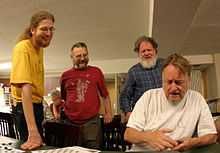Erik Demaine
| Erik D. Demaine | |
|---|---|
 | |
| Born |
February 28, 1981 Halifax, Nova Scotia, Canada |
| Residence | U.S. |
| Nationality | Canadian and American |
| Institutions | Massachusetts Institute of Technology |
| Alma mater |
Dalhousie University University of Waterloo |
| Thesis | Folding and Unfolding (2001) |
| Doctoral advisor |
Anna Lubiw Ian Munro |
| Doctoral students | Mihai Pătraşcu |
| Notable awards | MacArthur Fellow (2003) |
Erik D. Demaine (born February 28, 1981) is a professor of Computer Science at the Massachusetts Institute of Technology and a former child prodigy.
Early life
Demaine was born in Halifax, Nova Scotia. His parents are the artist sculptor Martin L. Demaine and Judy Anderson. Demaine was a child prodigy.[1] At age 7, he spent time traveling North America with his father, and was home-schooled until he entered college.[2][3]
he entered Dalhousie University in Canada at the age of 12, completed his bachelor's degree when only 14 and completed his PhD at University of Waterloo when only 20 years old.[4][5]
Professional accomplishments
Demaine's PhD dissertation, a seminal work in the field of computational origami, was completed at the University of Waterloo.[6] This work was awarded the Canadian Governor General's Gold Medal from the University of Waterloo and the NSERC Doctoral Prize (2003) for the best PhD thesis and research in Canada (one of four awards). This thesis work was largely incorporated into a book.[7]

He joined the MIT faculty in 2001 at age 20, reportedly the youngest professor in the history of the Massachusetts Institute of Technology.[4][8] Demaine is a member of the Theory of Computation group at MIT Computer Science and Artificial Intelligence Laboratory.
In 2003 he was awarded a MacArthur Fellowship, the so-called "genius award".
Mathematical origami artwork by Erik and Martin Demaine was part of the Design and the Elastic Mind exhibit at the Museum of Modern Art in 2008, and has been included in the MoMA permanent collection.[9]
In 2013, Demaine received the EATCS Presburger Award for young scientists.[10] That same year, he was awarded a fellowship by the John Simon Guggenheim Memorial Foundation.[11]
Honors and awards
- 2003. MacArthur Fellow.
See also
References
- ↑ Kher, Unmesh (2005-09-04). "Calculating Change: Why Origami Is Critical to New Drugs: The Folded Universe". TIME. Retrieved 28 February 2011.
- ↑ Barry, Ellen (2002-02-17). "Road Scholar Finds Home at MIT". Boston Globe. Retrieved 2008-04-15.
- ↑ Nadis, Steve (2003-01-18). "Prodigy prof skipped school until he started college at 12". New Scientist. Retrieved 2013-11-10.
- ↑ 4.0 4.1 Wertheim, Margaret (2005-02-15). "Origami as the Shape of Things to Come". The New York Times. Retrieved 2008-04-15.
- ↑ O'Brien, Danny (2005-08-19). "Commercial origami starts to take shape". Irish Times. Retrieved 2008-04-15.
- ↑ "National honour for Demaine". University of Waterloo. 2003-03-31. Retrieved 2008-04-15.
- ↑ Demaine, Erik; O'Rourke, Joseph (July 2007). Geometric Folding Algorithms: Linkages, Origami, Polyhedra. Cambridge University Press. pp. Part II. ISBN 978-0-521-85757-4.
- ↑ Beasley, Sandra (2006-09-22). "Knowing when to fold". American Scholar 75 (4).
- ↑ Curved Origami Sculpture, Erik and Martin Demaine.
- ↑ "Presburger Award 2013". Retrieved 15 February 2013.
- ↑ "Erik Demaine at the John Simon Guggenheim Memorial Foundation". Retrieved 23 April 2013.
External links
| Wikimedia Commons has media related to Erik Demaine. |
- Erik Demaine
- Erik Demaine at the Mathematics Genealogy Project
- Biography in MIT News
- Between the Folds Documentary film featuring Erik Demaine and 14 other international origami practitioners
| ||||||||||||||||||||||||
|
